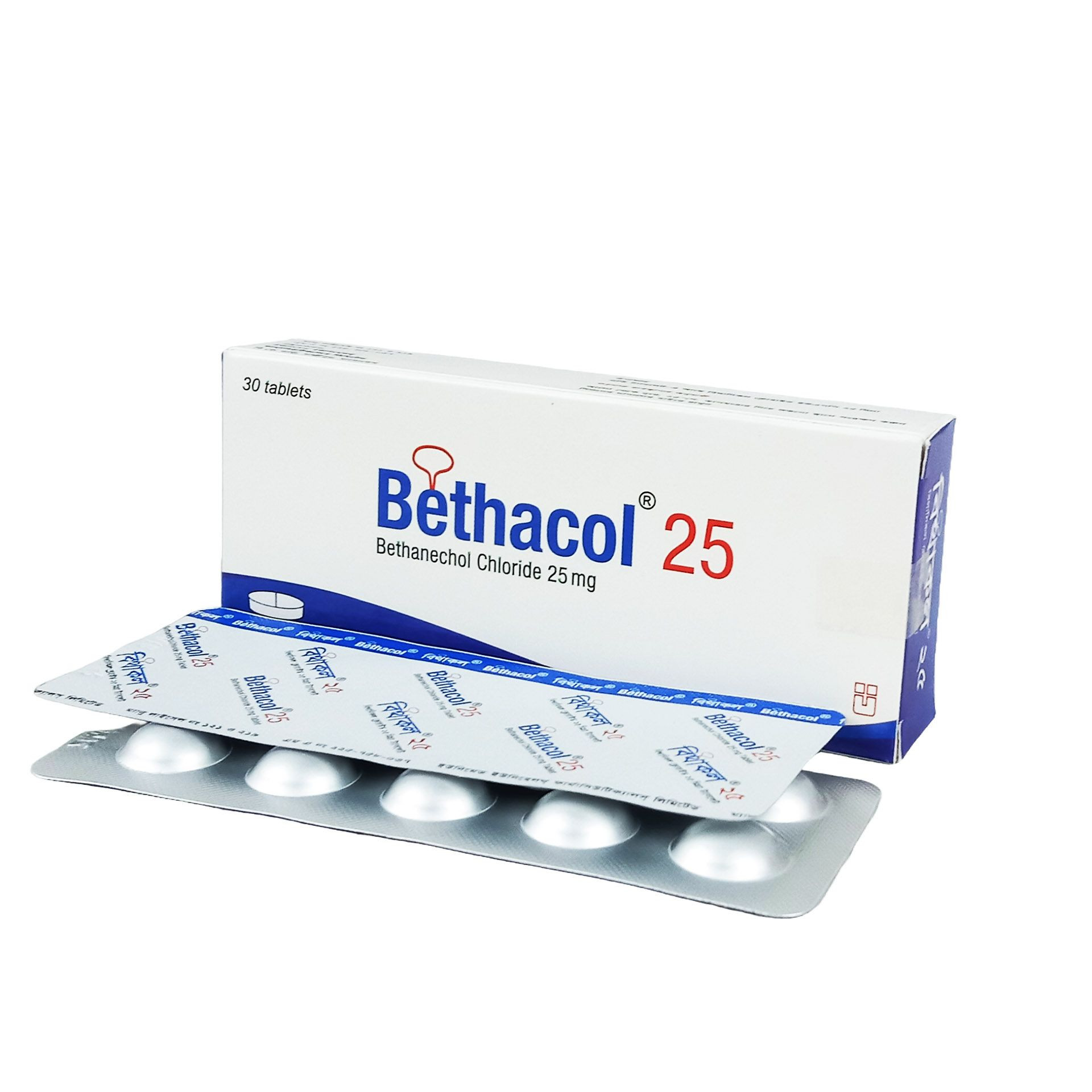Unit Price:
৳ 20.00
(3 x 10: ৳ 600.00)
Strip Price:
৳ 200.00
Indications
Bethacol is indicated for the treatment of acute postoperative and postpartum nonobstructive (functional) urinary retention and for neurogenic atony of the urinary bladder with retention.
Pharmacology
Bethanechol acts principally by producing the effects of stimulation of the parasympathetic nervous system. It increases the tone of the detrusor urinae muscle, usually producing a contraction sufficiently strong to initiate micturition and empty the bladder. It stimulates gastric motility, increases gastric tone, and often restores rhythmic peristalsis. Stimulation of the parasympathetic nervous system releases acetylcholine at the nerve endings. When spontaneous stimulation is reduced and therapeutic intervention is required, acetylcholine can be given, but it is rapidly hydrolyzed by cholinesterase, and its effects are transient. Bethanechol is not destroyed by cholinesterase and its effects are more prolonged and predictable than those of acetylcholine. It has predominant muscarinic action and only feeble nicotinic action. Doses that stimulate micturition and defecation and increase peristalsis do not ordinarily stimulate ganglia or voluntary muscles. Therapeutic test doses in normal human subjects have little effect on heart rate, blood pressure, or peripheral circulation.
Dosage & Administration
Dosage must be individualized, depending on the type and severity of the condition to be treated. Preferably give the drug when the stomach is empty. If taken soon after eating, nausea and vomiting may occur. The usual adult oral dose ranges from 10 to 50 mg three or four times a day. The minimum effective dose is determined by giving 5 to 10 mg initially and repeating the same amount at hourly intervals until satisfactory response occurs, or until a maximum of 50 mg has been given. The effects of the drug sometimes appear within 30 minutes and are usually maximal within 60 to 90 minutes. The drug effects persist for about one hour.
Pediatric Use: Safety and effectiveness in pediatric patients have not been established.
Pediatric Use: Safety and effectiveness in pediatric patients have not been established.
Contraindications
Hyperthyroidism, pregnancy, lactation, peptic ulcer, latent or active bronchial asthma, pronounced bradycardia or hypotension, vasomotor instability, coronary artery disease, epilepsy, parkinsonism. Should not be employed when the strength or integrity of the gastrointestinal or bladder wall is in question, or in the presence of mechanical obstruction; when increased muscular activity of the gastrointestinal tract or urinary bladder might prove harmful, as following recent urinary bladder surgery, gastrointestinal resection and anastomosis, or when there is possible gastrointestinal obstruction; in bladder neck obstruction, spastic gastrointestinal disturbances, acute inflammatory lesions of the gastrointestinal tract, or peritonitis; or in marked vagotonia.
Side Effects
Abdominal discomfort, salivation, flushing of the skin (hot feeling), sweating. Large doses more commonly result in effects of parasympathetic stimulation, such as malaise, headache, sensation of heat about the face, flushing, colicky pain, diarrhea, nausea and belching, abdominal cramps, borborygmi, asthmatic attacks and fall in blood pressure.
Pregnancy & Lactation
Pregnancy: Animal reproduction studies have not been conducted with bethanechol chloride. It is
also not known whether bethanechol chloride can cause fetal harm when administered to a pregnant woman or can affect reproduction capacity. Bethanechol chloride should be given to a pregnant woman only if clearly needed.
Nursing Mothers: It is not known whether this drug is secreted in human milk. Because many drugs are secreted in human milk and because of the potential for serious adverse reactions from bethanechol chloride in nursing infants, a decision should be made whether to discontinue nursing or to discontinue the drug, taking into account the importance of the drug to the mother.
also not known whether bethanechol chloride can cause fetal harm when administered to a pregnant woman or can affect reproduction capacity. Bethanechol chloride should be given to a pregnant woman only if clearly needed.
Nursing Mothers: It is not known whether this drug is secreted in human milk. Because many drugs are secreted in human milk and because of the potential for serious adverse reactions from bethanechol chloride in nursing infants, a decision should be made whether to discontinue nursing or to discontinue the drug, taking into account the importance of the drug to the mother.
Precautions & Warnings
Special care and consideration are required when bethanechol is administered to patients being treated concomitantly with other drugs with which pharmacologic interactions may occur. Examples of drugs with potentials for such interactions are: quinidine and procainamide, which may antagonize cholinergic effects; cholinergic drugs, particularly cholinesterase inhibitors, where additive effects may occur. When administered to patients receiving ganglionic blocking compounds a critical fall in blood pressure may occur which usually is preceded by severe abdominal symptoms. In urinary retention, if the sphincter fails to relax as bethanechol contracts the bladder, urine may be forced up the ureter into the kidney pelvis. If there is bacteriuria, this may cause reflux infection.
Storage Conditions
Keep below 30°C temperature, away from light & moisture. Keep out of the reach of children.


